Cooking
Classes at Kitchen Affairs
|
We have some
excellent classes scheduled for Spring. Whatever your cooking
interest, there's mst likely a class for you! Check out our website to see the
entire Class Schedule and
complete class descriptions.
Click
on the class title for full information! Call us at (812) 474-1131,
or stop in the store to register!
Monday, Apr 13 - 6:30
pm - Lighter Pasta
Dishes
with Doug Rennie.
$45.
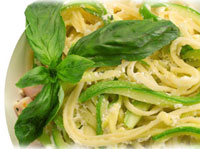 Wednesday, Apr. 15 - 6:30 pm - Go for the
Dough! Wednesday, Apr. 15 - 6:30 pm - Go for the
Dough!
with Shelly Sackett.
$40.
Sunday, Apr. 19 - 2:00
pm - Little Guys Make a Mom's
Day Brunch
with Peg
Neireiter. $40.
Tuesday, Apr. 21 -
9:30 am - Easy Does it Beef
Dinner
with Cindy Vescovi.
$30.
Tuesday, Apr. 21 -
6:30 pm - Biaggi's Beef and Pasta
Menu
with Sarah & Maria.
$55.
Thursday, Apr. 23 -
6:30 pm - A Beautiful Brunch for
Mother's Day
with Jennifer
Korb. $42.
Saturday, Apr. 25 -
9:30 am - Decorating Cookies for
Mom's Day
with Cathy Webb.
$40.
There
are more fantastic classes scheduled for April and May. Check our
website,
and call to reserve a place! (812)
474-1131! |
Butter
Basics
|
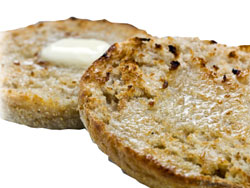 "Bread is but a canvas for good butter."
Historically, butter was peasant food just as bread was. It was
natural that they become inextricably linked. "Bread and
butter" is a time-honored idiom for describing one's source of daily
livelihood and well-being. Somewhere along the line, French
aristocracy discovered the pleasures of butter transforming it to a
much-in-demand food staple and key to many gastronomic
favorites. "Bread is but a canvas for good butter."
Historically, butter was peasant food just as bread was. It was
natural that they become inextricably linked. "Bread and
butter" is a time-honored idiom for describing one's source of daily
livelihood and well-being. Somewhere along the line, French
aristocracy discovered the pleasures of butter transforming it to a
much-in-demand food staple and key to many gastronomic
favorites.
What is
Butter? - For being a staple of kitchens everywhere, you may
be amazed about what you don't know about butter. Butter is
made from milk, most commonly cow's milk, but can be made from
sheep, goat, buffalo, yak, or other ruminating mammals' milk.
Butter is comprised of butterfat, milk proteins, and water.
According to legal food definitions, commercially produced butter
must have a butterfat content of at least 80%. Cow's milk has
a butterfat content of approximately 4%, so it takes a lot of milk
to make a pound of butter, in fact 10-11 quarts.
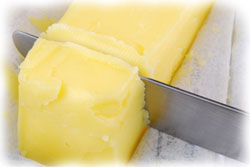 How Butter is Formed -- Suspended
in unhomogenized milk, the butterfat exists in tiny fat "bubbles"
with a thin membrane surrounding each globule of fat. Undisturbed,
the fat or cream, rises to the top of the milk and is easily skimmed
away to the butter churn. Agitating the skimmed cream will turn it
into butter. This agitation, or churning, breaks the membranes of
the fat globules allowing them to form longer chains of fat
"crystals" and coagulating in the process. Churned butter is
comprised of these butterfat crystals, loose butterfat, and unbroken
fat globules. The percentage of each form of butterfat will have an
impact on the consistency of the butter. As butter forms,
liquid separates from the fat. This liquid is known as
buttermilk. (However, most commercially-sold buttermilk is a
fermented skim milk, not the runoff from
butter-making). How Butter is Formed -- Suspended
in unhomogenized milk, the butterfat exists in tiny fat "bubbles"
with a thin membrane surrounding each globule of fat. Undisturbed,
the fat or cream, rises to the top of the milk and is easily skimmed
away to the butter churn. Agitating the skimmed cream will turn it
into butter. This agitation, or churning, breaks the membranes of
the fat globules allowing them to form longer chains of fat
"crystals" and coagulating in the process. Churned butter is
comprised of these butterfat crystals, loose butterfat, and unbroken
fat globules. The percentage of each form of butterfat will have an
impact on the consistency of the butter. As butter forms,
liquid separates from the fat. This liquid is known as
buttermilk. (However, most commercially-sold buttermilk is a
fermented skim milk, not the runoff from
butter-making).
Why is Butter
Yellow? -- The taste and yellow color of butter derive much
of their character from the pasture or feed given the dairy animal.
Nuances in taste between different dairies can be quite noticeable
and vary by farming region. Many commercial dairies add annatto, (a
seed from the achiote tree) or beta-carotene, (a natural plant
pigment), to their butter to amplify its yellow
appearance.
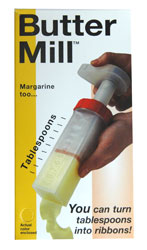 Butter Terms - The most common
butter term is "sweet cream
butter." Sweet cream butter is made from pasteurized
milk and contrasts with butter made from unpasteurized forms of
butter known as "raw cream
butter." In Europe, cultured
butter, where the cream has soured or fermented before
churning, is preferred. Whipped butter
is mechanically fluffed with nitrogen gas to be more
spreadable. Nitrogen gas is used to reduce the chances of
oxidation and spoilage that natural air might incite. Butter
commonly comes as salted butter
or unsalted
butter. Salt serves to preserve butter and enhance its
flavor, while unsalted butter allows the cook to adjust the salt
according to taste. Most baking recipes call for unsalted butter and
calibrate the amount of salt required in the recipe on that
assumption. Butter Terms - The most common
butter term is "sweet cream
butter." Sweet cream butter is made from pasteurized
milk and contrasts with butter made from unpasteurized forms of
butter known as "raw cream
butter." In Europe, cultured
butter, where the cream has soured or fermented before
churning, is preferred. Whipped butter
is mechanically fluffed with nitrogen gas to be more
spreadable. Nitrogen gas is used to reduce the chances of
oxidation and spoilage that natural air might incite. Butter
commonly comes as salted butter
or unsalted
butter. Salt serves to preserve butter and enhance its
flavor, while unsalted butter allows the cook to adjust the salt
according to taste. Most baking recipes call for unsalted butter and
calibrate the amount of salt required in the recipe on that
assumption.
Butter's
Nutrition - This is a bit of a sore subject. Butter is
80% fat; one tablespoon of butter contains 11 grams of fat, of which
64%, or 7 grams is saturated fat. It's this saturated fat
component that prompts us for some cautious moderation. One strategy
in balancing our intake of butter is to save it for when it really
counts -- where the flavor of butter is central to the food
experience. Other butter management strategies include using
whipped butter, or compound butters made of olive oil and
butter.
How to Store Butter - Butter may be
kept for several months under refrigeration and for up to six months
in the freezer. 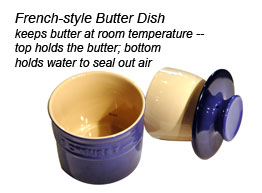 To prevent the
butter from picking up odors during storage, wrap it well. Butter,
like all food fats, can become rancid. Rancidity occurs over time
upon exposure to air and light; the long fat molecule chains break
apart into smaller fat chains and undesirable acids. Rancid fat is
not unsafe to eat, but will not taste very good. However,
refrigerated butter is not very spreadable. A French butter dish
allows butter to sit at room temperature for several days without
exposure to air. The two part dish utilizes water to form an
airtight seal, thus reducing the rate of butter's degradation. With
these unique butter pots spreadable butter is always
available! To prevent the
butter from picking up odors during storage, wrap it well. Butter,
like all food fats, can become rancid. Rancidity occurs over time
upon exposure to air and light; the long fat molecule chains break
apart into smaller fat chains and undesirable acids. Rancid fat is
not unsafe to eat, but will not taste very good. However,
refrigerated butter is not very spreadable. A French butter dish
allows butter to sit at room temperature for several days without
exposure to air. The two part dish utilizes water to form an
airtight seal, thus reducing the rate of butter's degradation. With
these unique butter pots spreadable butter is always
available! |
Butter and
Yolk Sauces
|
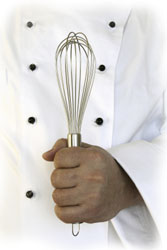 The pantheon of sauces is vast! Sauces are
often what transform the ordinary into extraordinary. But, we often
assume that sauces are best left to the experts and that they are
beyond the scope of the everyday kitchen. This, of course, is not
true! The pantheon of sauces is vast! Sauces are
often what transform the ordinary into extraordinary. But, we often
assume that sauces are best left to the experts and that they are
beyond the scope of the everyday kitchen. This, of course, is not
true!
There are basic families of sauces from which an
endless variety of other sauces emerge. We'll explore a few of these
sauces that depend on butter and learn some of the science behind
what makes these sauces work.
One prominent family of
sauces featuring butter is the Hollandaise family. Sauces in
this group combine egg yolks, some acidic component, and butter into
a topping that has both visual and flavor appeal. Once you learn the
basics of Hollandaise, the techniques transfer to the related
sauces.
Making Hollandaise
Sauce - This classic sauce coaxes together liquids, oil and
water, that would not normally mix. This combining process is known
as emulsification. It begins by melting one cup of butter and
keeping it quite warm. Combine three egg yolks and one tablespoon of
lemon juice in a heavy saucepan. Heat and whisk the yolk mixture
gently just until it begins to thicken. Drip in a small amount of
the hot, melted butter while continually whisking. Continue to
drizzle in the butter and stir until all of the butter is
incorporated. Remove from heat. A well-made Hollandaise will keep
for about 30 minutes before serving.
Sauce Secrets for a Great
Hollandaise:
- Mind the Temperatures - Start with a cold saucepan, cold
yolks, and cold lemon juice. Apply heat very gradually.
- Stir diligently - Throughout the process, stir the sauce
continually with a whisk taking care to catch the edges and
corners of the pan.
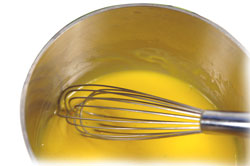 Add the warm, melted butter just as
the yolks are beginning to thicken. Too early and the thickening
will be slowed; too late and the yolks may curdle or scramble. Add the warm, melted butter just as
the yolks are beginning to thicken. Too early and the thickening
will be slowed; too late and the yolks may curdle or scramble.
- Add the warm butter gradually, especially at the beginning.
The egg yolks act as an emulsifier for combining the water-based
juice with the oil-based butter; give them a chance to do their
work.
- Some instructions for Hollandaise sauce call for reserving two
tablespoons of cold butter. Add the first cold tablespoon to the
yolk mixture at the start of heating. The cold butter
moderates the heat application to the yolks. When the cold
chunk of butter is completely melted and incorporated into the egg
yolks, the remaining hot,melted butter may be drizzled in. Use the
second cold tablespoon of butter to cool down the sauce at the
very end.
- If the Hollandaise Sauce separates prior to serving, this may
be the result of applying too much heat, adding the butter too
quickly, or using too much butter. If the sauce is just beginning
to separate you may be able to heal it with the addition of a
tablespoon of cold water or cold cream.
Variations in
the Hollandaise Family of Sauces - From this
basic sauce wonderful variations are available:
Sauce
Maltaise - This sauce
adds one tablespoon of orange juice along with the lemon juice in
the egg yolk mixture. An additional 3-4 tablespoons of orange
juice and a teaspoon of orange zest are whisked into the completed
sauce.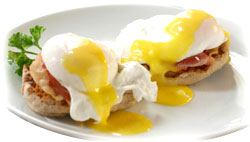
Béarnaise Sauce
- In this sauce, the lemon juice is replaced with a reduction of
white wine vinegar laced with finely chopped shallots and tarragon.
The result is a richly flavored sauce that complements meat,
chicken, fish, and egg dishes.
Sauce Choron -
To the basic Béarnaise Sauce, add 2-3 tablespoons of tomato paste
before serving. This variation is also great with meat, chicken,
fish and egg dishes. |
Roux-based
Sauces
|
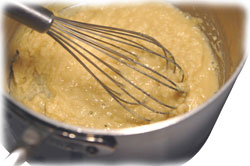 White sauces, another classic family of sauces,
begin with a mixture of flour and butter with different liquids and
flavorings added for a wealth of possibilities. White sauces, another classic family of sauces,
begin with a mixture of flour and butter with different liquids and
flavorings added for a wealth of possibilities.
A basic
white sauce begins with four tablespoons of butter melted in a heavy
saucepan. Six tablespoons of flour are added all at once to the
melted butter. Over medium heat, the flour and butter mixture are
continually stirred; this flour and butter mixture is known as a
roux
(rhymes with "boo"). The heat should be strong enough to keep the
roux bubbling, but not so
strong as to turn the mixture brown. Once the roux has cooked, add 2 cups of
very hot milk to the roux
all at once and stir briskly. The sauce will thicken quickly. Season
the sauce with salt and pepper.
Sauce Secrets for Roux-based Sauces:
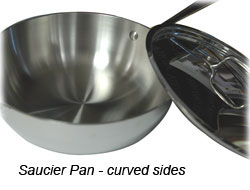 Cook and stir the roux for a full 2 minutes before
adding the liquid. During those two minutes, a chemical
reaction takes place that eliminates any raw, pasty taste in the
flour. Don't rush this step. Cook and stir the roux for a full 2 minutes before
adding the liquid. During those two minutes, a chemical
reaction takes place that eliminates any raw, pasty taste in the
flour. Don't rush this step.
- Use a stainless steel or enameled saucepan with curved edges,
also known as a saucier pan. The sloped sides of the pan make it
easy to whisk and stir without any of the roux getting stuck in the corner
of the pan and scorching.
- Heating the liquid to be added to a near boil will help
prevent any lumps in the resulting sauce. If lumps should appear,
whisk vigorously. If persistent, strain the sauce through a fine
sieve.
A raw roux, a
mixture of butter or oil and flour, kneaded by hand into a raw
paste, is called beurre manie,
or "hand butter." Many chefs keep this on hand to speed the
thickening of a sauce or soup. Simply add it, one teaspoonful
at a time, to your sauce or soup, stir to dissolve and wait at
least a minute to see what the effect is. If the sauce is still not
thick enough, add another spoonful. You will quickly learn how much
to add to thicken your sauce to your preference.
A blonde roux, is
a roux which is cooked until smooth, but not colored. This roux is
the basis for white and cream sauces, and does not add a flavor
component to the dish beyond the flavor of the butter
itself.
A mahogany or red
roux is used extensively in southern cooking. My grandmother
used to say that "a good roux is the same color as good furniture,
and as thick as furniture paste." This is cooked over medium or
medium-low heat (never high heat) until the roux is indeed mahogany
or dark red in color. This type of roux is used both to thicken and
to flavor sauces, soups, and often rice dishes (think jambalaya or
etouffee). Be careful not to scorch this roux, and stir vigorously
when it starts to color, or you will end up throwing it out and
starting over. If you have to start over, be sure the pan is
completely clean or you will scorch the second batch as
well.
Variations in the Roux-based Family
of Sauces - From a basic
white sauce many versatile variations are available:
Béchamel Sauce
- This sauce is the classic white sauce where the liquid is milk. As
a "mother sauce" it provides the basis for many other sauces. One
variation calls for half beef stock and half milk for the liquid
portion of the sauce.
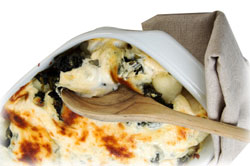 Mornay
Sauce - To the basic
white sauce, grated cheese is added, half Gruyère and half
Parmesan. The sauce is often served with seafood, vegetables,
or as the base for a gratin. Mornay
Sauce - To the basic
white sauce, grated cheese is added, half Gruyère and half
Parmesan. The sauce is often served with seafood, vegetables,
or as the base for a gratin.
Sauce Soubise -
Onions (4 cups) are wilted in the butter before the roux's flour is
added. At the finish, the sauce is pureed to smoothness. Add a few
tablespoons of cream as the sauce is reheated, and you'll have a
sublime result.
|
Smart Butter
and Basic Sauce Tips
|
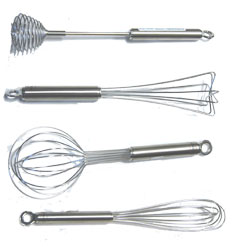 Tip
#1: Sauce-making requires good use of a whisk.
Whisks come in all different sizes and shapes. Each is designed to
combine ingredients efficiently while incorporating air into the
mixture. Use your wrist to work the whisk in a circular
motion. Tip
#1: Sauce-making requires good use of a whisk.
Whisks come in all different sizes and shapes. Each is designed to
combine ingredients efficiently while incorporating air into the
mixture. Use your wrist to work the whisk in a circular
motion.
Tip #2:
Serve compound butters for an easy, elegant touch. Devise your
own compound butters by mixing finely chopped herbs into softened
butter. Make sure fresh herbs are well air-dried after
washing. Make a frugal version of truffle butter by adding
several drops of truffle oil into softened butter. "Logs" of
compound butters may be wrapped and frozen for future
use.
Tip #3: For
Hollandaise-like sauces with acidic ingredients, use a stainless
steel or enameled saucepan to reduce any reactivity that might
discolor or add an undesirable metallic flavor to the sauce. A
thick-walled saucepan will promote the even transfer of heat and
help prevent curdling and scorching.
Tip #4: Try different types
of butter for nuanced tastes - butters from other regions or
countries, or butter from goats or other animals.
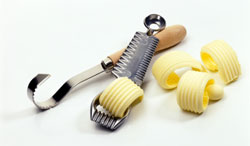 Tip
#5: Present individual portions of butter at each table
setting as small individual molds, or a series of butter
curls. To curl butter, the butter must not be too cold or too
hot. About 60 - 70° F is the perfect temperature for dragging
a butter-curling tool along a stick of butter. After creating the
curls and placing them on individual small plates, chill the dish
until serving time. The butter will soften quickly once
served. Molds used for candy-making may also be used to create
individually-sized butter molds. Tip
#5: Present individual portions of butter at each table
setting as small individual molds, or a series of butter
curls. To curl butter, the butter must not be too cold or too
hot. About 60 - 70° F is the perfect temperature for dragging
a butter-curling tool along a stick of butter. After creating the
curls and placing them on individual small plates, chill the dish
until serving time. The butter will soften quickly once
served. Molds used for candy-making may also be used to create
individually-sized butter molds. |
Q &
A's
|
 Q: What is clarified
butter? What is ghee? Q: What is clarified
butter? What is ghee?
A:
Clarified
butter is nearly pure butterfat. Butter is melted separating its
components into butterfat, water, and milk proteins. The foamy white
particles formed from the milk proteins are skimmed away leaving the
pure butterfat, or clarified butter. Ghee, popular in Indian
cooking, is clarified butter that has been heated to 250° F
evaporating any residual water and turning the milk proteins a
golden color. The "toasted" milk proteins are removed from the
butterfat, but leave behind a delicious nutty flavor. Click this
link to view a mini-video of How to Clarify Butter. (Courtesy of
the Wisconsin Cheese Board).
Q: What is the proper way to eat
butter at the dining table?
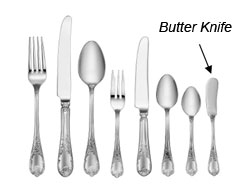 A:
Butter at the
dining table takes on a "condiment" role. Butter may be placed
individually at each place setting, or served to diners from a
common dish. At formal dinners, a butter knife will be a part
of each place setting; it is a petite knife without sharp
edges. When served bread, take a portion of butter from the
common dish and place on the side of your bread plate. Break
off a small, bite-sized portion of bread and using your butter
knife, place butter on that piece only. Never slather a whole
piece of bread with butter at one time, and do not create a "butter
sandwich." "One bite at a time" is proper bread and butter
etiquette. A:
Butter at the
dining table takes on a "condiment" role. Butter may be placed
individually at each place setting, or served to diners from a
common dish. At formal dinners, a butter knife will be a part
of each place setting; it is a petite knife without sharp
edges. When served bread, take a portion of butter from the
common dish and place on the side of your bread plate. Break
off a small, bite-sized portion of bread and using your butter
knife, place butter on that piece only. Never slather a whole
piece of bread with butter at one time, and do not create a "butter
sandwich." "One bite at a time" is proper bread and butter
etiquette.
Q: What is brown
butter?
A:
Brown butter,
or beurre noisette, is a classic chef's secret for creating
fantastic flavor. Cold butter is melted and allowed to barely
simmer over heat. The milk proteins will produce a white foam
on top. As the milk proteins "cook" they will brown and sink
to the bottom. When the top foam of the butter is a light
brown, remove from heat and allow it to cool. Strain the golden
butter to remove any browned protein particles, then use as a simple
sauce or sauce component. The "browning effect" of the heated
proteins produces a wonderfully nutty flavor. Click this link to
view a mini-video of How to Brown Butter. (Courtesy of
the Wisconsin Cheese
Board). |
Cookbook
Review
|
The Silver
Palate Cookbook, 25th Anniversary Edition by Julee Russo and
Sheila Lukins. Published by Workman Publishing Company, Inc.,
New York, NY. Copyright 2007.
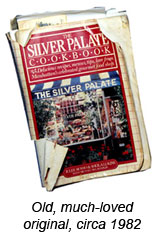 We're always intrigued with the latest cookbook,
but we often come back to the classics. How does a cookbook
become a classic? It stands the test of time and produces
reliable results again and again. A favorite cookbook will
show the marks of true love -- the pages become tattered, perhaps a
few splatters marks, or corners dogged-eared. The original
Silver
Palate Cookbook is one of those books in our kitchen. We're always intrigued with the latest cookbook,
but we often come back to the classics. How does a cookbook
become a classic? It stands the test of time and produces
reliable results again and again. A favorite cookbook will
show the marks of true love -- the pages become tattered, perhaps a
few splatters marks, or corners dogged-eared. The original
Silver
Palate Cookbook is one of those books in our kitchen.
 We're so pleased that Julee Russo and Sheila
Lukins have decided to update their classic with The Silver
Palate, 25th Anniversary Edition. The Silver Palate
Cookbook grew out of their successful catering business and
contains basics, but so much more. This cookbook has introduced
countless individuals to the enjoyment of cooking one's own food,
and the ease with which good-tasting, good-looking food can be
assembled. The sidebars of each page are generously populated
with tips and hints about the recipe, or perhaps about entertaining,
or some fascinating back story. If you missed The Silver
Palate the first time around, the 25th Anniversary Edition is ready
for you now. You'll quickly understand why this cookbook has
earned the reputation of
"classic!" We're so pleased that Julee Russo and Sheila
Lukins have decided to update their classic with The Silver
Palate, 25th Anniversary Edition. The Silver Palate
Cookbook grew out of their successful catering business and
contains basics, but so much more. This cookbook has introduced
countless individuals to the enjoyment of cooking one's own food,
and the ease with which good-tasting, good-looking food can be
assembled. The sidebars of each page are generously populated
with tips and hints about the recipe, or perhaps about entertaining,
or some fascinating back story. If you missed The Silver
Palate the first time around, the 25th Anniversary Edition is ready
for you now. You'll quickly understand why this cookbook has
earned the reputation of
"classic!"
|
Recipes with Basic
Sauces
|
Recipes excerpted from the Silver
Palate Cookbook 25th Anniversary Edition by Julee Rosso and Sheila Lukins.
Copyright 2007. Used by permission of Workman Publishing Co., Inc.
New York, NY. All Rights Reserved.
Hollandaise
Sauce with Spring
Asparagus
 Hollandaise Sauce is a perfect
complement to spring's early vegetables - asparagus and artichokes -
or drizzled on top of fish. Of course, a good Hollandaise tops the
classic brunch dish, Eggs Benedict. Deploy this sauce on any
occasion calling for a buttery, lemon flavor! Hollandaise Sauce is a perfect
complement to spring's early vegetables - asparagus and artichokes -
or drizzled on top of fish. Of course, a good Hollandaise tops the
classic brunch dish, Eggs Benedict. Deploy this sauce on any
occasion calling for a buttery, lemon flavor!
Click here to view the
recipe.
Click here for a printable version of
the recipe
(PDF
format).
Béarnaise
Sauce with Filet of Beef
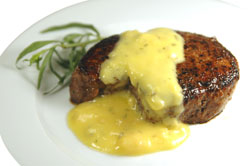 In our early days of cooking, this sauce
was the one that introduced us to the wonderful flavors of tarragon.
The delicate herb, the piquant white wine vinegar, and aromatic
shallots, awaken the palate preparing it for the full flavors of
that which it graces. The classic pairing of Tenderloin of
Beef with Béarnaise Sauce is a worthy place to begin your
appreciation of this sauce. In our early days of cooking, this sauce
was the one that introduced us to the wonderful flavors of tarragon.
The delicate herb, the piquant white wine vinegar, and aromatic
shallots, awaken the palate preparing it for the full flavors of
that which it graces. The classic pairing of Tenderloin of
Beef with Béarnaise Sauce is a worthy place to begin your
appreciation of this sauce.
.
Click here to view the
recipe.
Click here for a printable version of
the recipe
(PDF
format).
Béchamel Sauce
in Vegetarian Spinach Lasagna
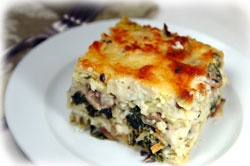 True to its tagline, Béchamel Sauce is a
"mother sauce." This sauce begins with a butter-flour roux and
becomes a silky, smooth white sauce that can be transformed into any
number of flavorful variations. With this Vegetarian Spinach
Lasagna, the Béchamel Sauce takes the place of the red sauce found
in traditional lasagna. Richly-flavored with onions and
mushrooms, and brightly-colored with spinach and grated carrots,
this lasagna is a hearty and satisfying do-ahead meal. True to its tagline, Béchamel Sauce is a
"mother sauce." This sauce begins with a butter-flour roux and
becomes a silky, smooth white sauce that can be transformed into any
number of flavorful variations. With this Vegetarian Spinach
Lasagna, the Béchamel Sauce takes the place of the red sauce found
in traditional lasagna. Richly-flavored with onions and
mushrooms, and brightly-colored with spinach and grated carrots,
this lasagna is a hearty and satisfying do-ahead meal.
Click here to view the
recipe.
Click here for a printable version of
the
recipe
| |